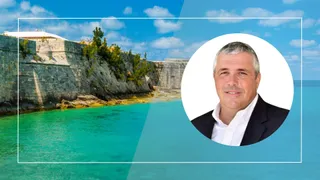.jpg/r%5Bwidth%5D=320/c84561a0-531a-11ef-956e-b78395160c62-Bermuda%20and%20CI%20image%20templates%20(2).webp)
Location, location, location
Bermuda is poised to become a major hub for undersea cable traffic after Google announced Bermuda will be a stop on a new transatlantic cable called Nuvem between Portugal and South Carolina.
While this hub will give Bermuda its first direct fibreoptic cable to Europe since the Cable & Wireless PTAT cable, which had a spur to Bermuda, ceased operations in 2004, Bermuda is likely to become a hub for many more cables.
That’s because Google, which is a world leader in cloud storage, plans to lay a “mesh” of cables across the Atlantic to create redundancy and resilience.
“For network engineers, the mesh is the Holy Grail of networking.” David Robles, Google
David Robles, global subsea construction lead for Google, told the Bermuda Tech Summit in October that Google’s data centres around the world needed the cable network to update and back up capacity.
“For network engineers, the mesh is the Holy Grail of networking, where every point is connected to every other point through multiple paths, and this is what we are trying to achieve in the Atlantic,” said Robles.
“That is why Bermuda is so strategic. By putting multiple cables into Bermuda over the long term, it will allow us to achieve this mesh architecture, which is extremely resilient.”
He said Bermuda was ideally suited as a hub for cables and the regulatory framework enacted in 2020 had removed much of the uncertainty which often surrounds cable infrastructure.
“Take that unique geography and ability to serve as a hub and apply it to undersea fibreoptics,” he said. “We are here to talk about Nuvem for the moment, but as a longer-term vision, we can project forward and say, ‘Bermuda makes sense for many other things’. You can envision cables going from different parts of Europe and perhaps to northern Africa, perhaps to Latin America.
“That is where we start to see Bermuda’s value as a hub. It provides a point where we can switch between all those different cables and provide an extremely secure network architecture.”
In particular, he said, the fact that the framework identified Devonshire Bay and Annies Bay in Southside, St David’s as the preferred landing zones for submarine cables simplified the permitting process.
In other countries, cable operators were forced to spend months finding landing points and getting the necessary approvals, he added.
“This simplifies the process of permitting and route surveys,” he said. “The framework also contains licensing, fee structures and timelines. Usually, we do not have that certainty.”
A landing station
In addition to land sites for submarine cables, Google would construct a cable landing station which would require between and 10 and 20 staff, Robles said.
“Capacity on the system would be offered on a wholesale basis to established carriers.”
He said the station would be a low traffic site and would rely on solar energy to the greatest extent possible for power, with solar panels located on the roof and surrounding grounds.
Google hoped to conduct a cable survey this month, to construct the building in 2025 and to open it in 2026, he said. The cables were expected to have a 25-year lifespan and Google expected to be in Bermuda for 40 to 50 years.
While the main purpose of the cable landing station was to support telecommunications around the Atlantic, capacity on the system would be offered on a wholesale basis to established carriers.
“Google’s vision is to serve long-term customers, and to establish resilient connections from Bermuda to enterprise customers around the world,” he explained.
In answer to questions from moderator Stephen Rees Davies about the certainty the submarine cables legislation gave Google, he said: “Any cable project is difficult because you don’t know how long it will take.”
But, he said, the timelines and detail provided by Bermuda’s regulatory framework took much of the difficulty away.
Robles welcomed the fact that the legislation required an environment impact study, but said that by and large, submarine cables were environmentally benign as they became part of the ocean environment.
He added that Google would look to have the lowest possible environment impact during the construction process by identifying the closest point for landing materials.
Google would also do its best to hire and train Bermudians, he said.
Did you get value from this story? Sign up to our free daily newsletters and get stories like this sent straight to your inbox.

